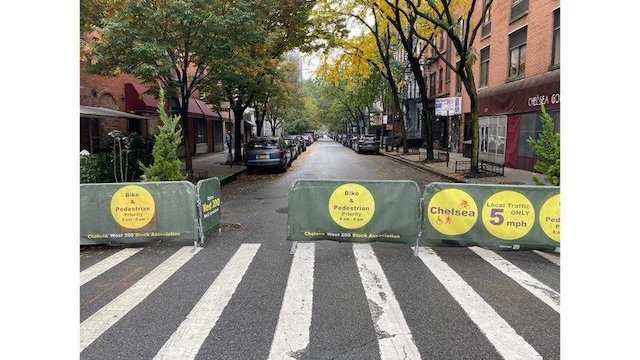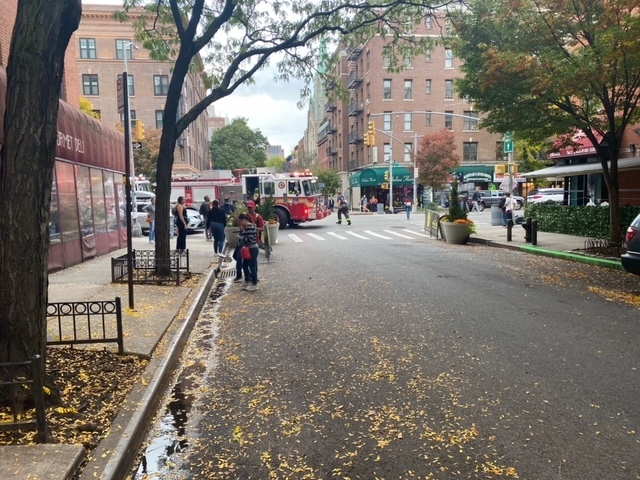
By Molly Harris, Carin Ehrenberg, Nico McLane, Terry Cundiff, Kathy Ellman, Diane Lazarus, Cindy Loomis, Joe Neuhaus, Jeff Preston, Steven Schram, Aaron Schwarz, Melissa Stern, Aida Thomas, Lowell Thomas, and Amelia Weir.
Early in the pandemic, the City temporarily closed several streets in Chelsea to create outdoor areas during a time when residents were cooped up in isolation. Some of those streets re-opened, but not the 200 Block of West 22nd Street. It turns out the block association for that block obtained a grant from the City and closed the street under the City’s Open Streets program. We are residents of that block and surrounding blocks, and we think it is time to remove the barricade and re-open the block. Here’s why.
You may know about the Open Streets program, because it has resulted in closings of streets in front of schools and created outdoor dining that has benefited customers and owners of hard-hit restaurants. What you may not know is that it could result in the closing of a completely random block just because someone undertakes to maintain the barriers, and this is what happened on the 200 Block of West 22nd Street. That block is a particularly poor choice to close to traffic, for several reasons:
–There are no restaurants with entrances on the block.
–There are no schools, police stations, or parks on the block.
–There isn’t even a bike lane on the block—those are on 20th and 21st Streets.
–There is, however, a large indoor parking garage that serves many residents in the area.
–That means that this particular block will never be able to be closed for vehicular traffic and the gate that is there inevitably needs to be opened by drivers several dozen times a day.
–Traffic flow in the neighborhood has already been diverted by bus lanes and restricted turns on 23rd Street—useful and well-thought-out improvements. But adding diverted traffic from the now-closed 22nd Street increases congestion and pollution.
–Three other nearby streets are already closed to traffic much of the day, which means further diverted traffic on surrounding streets that are open: The 200 Block of West 20th Street—two blocks south—is frequently closed because of a police precinct; the 300 Block of West 21st Street is closed during PS 11 school hours; and the 400 Block of West 21st Street is another “Open Street” with barriers.
Limiting access to West 22nd Street is a major safety and accessibility concern. Drivers have to stop in the crosswalk and block Eighth Avenue traffic to move the barriers. Those with children are forced to leave their car and children unattended while they open and close the barriers. In addition, emergency vehicles are slowed down in their response. The father of one of us had an emergency last year and the barriers slowed down the ambulance; he nearly died. We also have often had taxis, Ubers, and Lyfts refuse to come down the block for pick up or drop off, saying that they think they aren’t allowed to do so. These barriers have made life more difficult for the elderly, families with children, and anyone else who occasionally needs or wants access to a car.
Closing this block is a privilege for a few residents who want a private, City-funded front yard, but causes inconvenience and additional safety hazards to many of their neighbors. And it has already badly impacted the garage, which used to have six parking attendants and now has reduced hours and only three attendants. That’s three jobs that haven’t come back after the pandemic.
All of these negatives come with little or no positive benefit. During the closure, there has been no substantial use of the closed block for play space or recreation, and it can never be entirely closed to traffic.

We’re not opposed to measures to introduce more car-free space in Manhattan—and temporary closures for one-day events can be great. But closing a street on a full-time basis should be done intelligently and not randomly because a few residents want it. Other areas of Manhattan that have had streets closed have been where there is little impact to the normal flow of traffic. In other cities where this has been done, the authorities choose peripheral streets that don’t affect traffic flow. Or they create large car-free zones with careful thought as to where the cars will go. None of that has been done here.
According to Colleen Chattergoon, the Senior Manhattan Borough Planner for NYC Department of Transportation (DOT), the Open Streets designation of this block will expire at the end of December, but it can be renewed. Also, a group called the “West 22nd Street Open Street Task Force” advised the Transportation Planning Committee of the local Community Board (CB4) last month that it plans to submit a report to seek approval and additional city funding for some form of further changes to the block in mid-December. We plan to urge that the barriers be removed, and the street be reopened as soon as possible. We hope that others will join us.
If you agree, here’s what you can do:
–Sign our petition on change.org https://www.change.org/west22ndstreetforall.
–DOT has an easy-to-use form to express concerns about the Open Streets program and specifically this particular block—here’s the link https://www1.nyc.gov/html/dot/html/contact/contact-form.shtml (you need to select Open Streets and then type in the block).
–Write to Council Member Erik Bottcher at ebottcher@council.nyc.gov.
–Contact Community Board 4 at jbodine@cb.nyc.gov.
–Let us know of your support by emailing west22ndstreetforall@gmail.com — we’ll let you know when this will be considered by the Community Board.
We need to get the City back to normal. Bringing down these barriers is a small step that will help.
—END—
Note: The statements, assertions, and interpretations of our Guest Opinion contributors are their own and not necessarily shared or endorsed by Chelsea Community News.
Chelsea Community News is made possible with the help of our awesome advertisers, and the support of our readers. Please consider taking part in our GoFundMe campaign (click here). To make a direct donation, give feedback, send a Letter to the Editor, or contact our founder/editor, email scott@chelseacommunitynews.com.

Pingback: Guest Opinion: Keep Open Street Designation, as Redesign Process Plays Out – Chelsea Community News